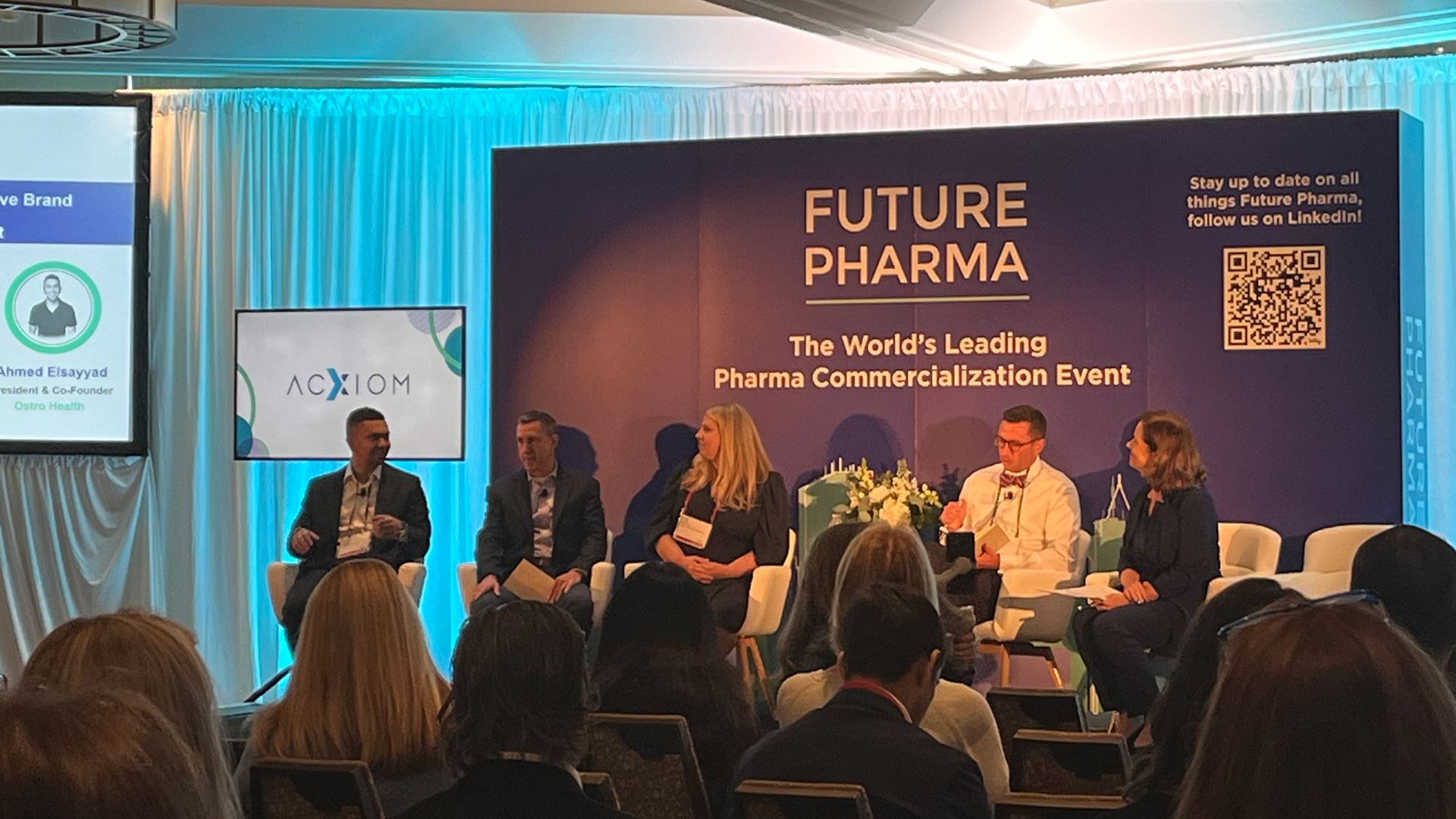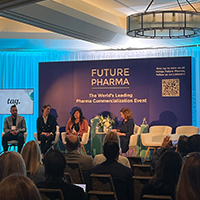ChatGPT will write your brand story if you don’t
(and four more AI insights from Future Pharma)
This past summer, I attended a gathering of pharma marketing executives in my hometown of Boston, US. At the Future Pharma conference, a Who’s Who of big pharma marketers shared their perspectives on how their space is changing, and one change came up again and again: the rise of generative AI.
But implementing Gen AI in a thoughtful, compliant, efficient, and effective way is much easier said than done. Below are a handful of insights shared at the show that point to what AI can do, and how to do it right.
ChatGPT will write your brand story if you don’t
Right now everyone in the industry is scrambling to use generative AI in the right way. But one speaker pointed out that generative AI is going to affect your business whether you use it or not.
Bill Berry, general manager life sciences and healthcare at Constellation and former head of US general medicines business operations and transformation at Sanofi, said one eye-opening thing marketers can do right now is ask ChatGPT to describe your brand. Or better yet, just Google your brand. Either way, you’ll see an AI-generated summary, which, going forward, will be the first thing customers learn about you whether you like it or not.
“These platforms will develop a narrative for your brand if you don't,” Berry said. “So, be thinking about the fact that these [large language models] are actually a new audience for you. So, when you think about digital marketing, it's not just the individuals that will be your audience. What's going to be your strategy to make sure you're putting content in the right places in the right forums to shape what those particular narratives are?”
AI offers a competitive advantage for smaller players
Big pharma is making big investments in AI, including Sanofi, whose CEO proclaimed the company “all in on AI” last year. But Boaz Kigel, Sanofi’s senior director for global oncology commercial, says that doesn’t mean they necessarily have the advantage over smaller biotechs in this moment of transformation.
“Do not assume that in big pharma we know better than you,” he told the crowd. “You could be more agile, quick on your feet, incorporate new technologies, and think about better ways to reach the market, as opposed to the rigid way that big pharma has been doing things. You have less money, but sometimes less is much better because then you prioritise, then you choose your target more efficiently. You're not just shooting all over the place.”
Kigel believes that in five years AI will have transformed everything about how pharma does business, so the opportunity to apply it faster and to have that advantage is naturally limited.
“At the end of the day, specifically when you work in big pharma, those are companies with 100,000 employees,” he said. “It's a big ship to steer. There is a lot of politics, a lot of chain of command, a lot of processes. It's very different than working in a small biotech.”
You have to walk before you can run
Generative AI is where the hype is in the industry right now, and its possibilities are especially exciting for pharma marketing. But its drawbacks are also especially concerning for the highly regulated industry.
Marty Kovach, global content strategist at Merck, told Future Pharma attendees to “beware of generative AI”.
“I am very sceptical when someone says to me, I'm going to skip modular content. I'm just going to go to generative AI,” he said. “At your own peril, because generative AI will never give you the consistency that your reviewers are going to need, and the content that you might get will be hallucinated. And are you going to train the generative AI LLM with your label? And if your label changes, guess what? You're going to start from scratch. So you have to be very careful and get really smart around generative AI, what the cost is, and what the effort is, and what you're going to get out of it.”

All event photographs courtesy of Jonah Comstock
Kovach says the role he sees for generative AI is to make suggestions to speed up human content generation, supported on the front end by traditional AI.
“How do we translate data into insights, and then insights into what we call a recipe? Based on that customer, which combination of content do they receive? And once we have that, how do we measure the performance of that content? How well did that promotional message perform?” he said. “So, we’ve got to think about using traditional AI, not generative AI, traditional AI, to gather that information and to make the correct recipes. Then, once you understand the performance of content, the next step is to think about generative AI.”
Expertise and understanding the problem are vendor differentiators
Catherine Blanchette, Sanofi’s head of digital strategic partnerships, says her company is leaving no stone unturned in looking for digital solutions.
“I do think about the whole spectrum of innovation and, of course, it takes a village,” she said. “We think about vendor relationships, strategic partnerships, corporate venture capital, seed funding, and incubation as well. There's a wide variety of levers you can pull, and it really depends on what sort of impact you want to have. But our approach is a very multifaceted one.”
But how does big pharma select its innovation partners? On the same panel, Bristol Myers Squibb's head of digital and IT, Jalpa Dave, says they’re always making sure that new technology is in service of larger business goals.
“If we're specifically talking about bringing external solutions in-house, the important thing to remember is that everything needs to be strategy-driven,” she said. “The solution is a how. What's the why? What's the North Star vision you have for solving a problem? And the problem should be pretty ambitious. Then the ‘how’ can be a combination of external or internal innovation. But we always want to start with that 'why?' What is that vision?”
So that vendors can be helpful by proving they really understand the problem, the pain points, and the customer journey as well as companies do, she said.
“Help us see around corners,” Blanchette said. “Help us leverage your expertise as thought leaders in the industry. That's a differentiator for us. We have thousands of vendors that contact us on a daily basis. We have tens of thousands of suppliers in our cold chain. So, just a regular cold call or discussion or marketing outreach is not going to resonate with my particular group.”
AI is a speed play, but speed is important
Several speakers espoused the idea that AI is a tool, to be used if and only if it’s the right tool for the job. Often, for sales teams, that’s as a force multiplier and an efficiency play.
“Right now, our targets, our consumers and our doctors are scattered all over the world, all over the web, and they are loyal to a couple of places, but they may go to multiple,” Heath Morlok, the associate director of integrated customer engagement in oncology at Merck, said. “And so we really have a hard time being everywhere at once. So, the solutions that really help us simplify things, help us be present in those multiple places. Where I think AI as a tool may help is to get us in just more quickly, condensing some of that information, some of that data, and being present.”
When it comes to patient services, AI is being used already in lots of ways, Louis Savant, director of patient access transformation strategies at Teva, said. It’s a speed play, but speed really matters.
“The advantage of AI is that it just helps you do things that you used to be able to do much faster. And in the patient services world, our activities, we call it south of the script. The script has already been generated, and now we're trying to look further. And every day that goes by that the patient doesn't get the medicine filled, the likelihood that it gets filled gets lower and lower. So, getting patients through the benefit verification process, the prior authorisation process, and everything, getting the script filled faster is better for patient care, and now it's a better business. It's the speed that's really important.”
As the dust settles from this year’s Future Pharma event, it's clear that AI isn't just another buzzword in the pharmaceutical industry. From ChatGPT crafting brand narratives to AI potentially levelling the playing field between pharma giants and small operation biotechs, the implications are far-reaching. Yet, as Merck's Marty Kovach cautions, the industry must temper its enthusiasm with pragmatism. The path forward lies in strategic implementation: using traditional AI to gather insights and craft "recipes" for customer engagement, leveraging AI to accelerate human-driven content, and partnering with vendors who truly understand pharma's unique challenges.
About the author
Jonah Comstock is a veteran health tech and digital health reporter. In addition to covering the industry for nearly a decade through articles and podcasts, he is also an oft-seen face at digital health events and on digital health Twitter.
Supercharge your pharma insights: Sign up to pharmaphorum's newsletter for daily updates, weekly roundups, and in-depth analysis across all industry sectors.
Want to go deeper?
Continue your journey with these related reads from across pharmaphorum
Click on either of the images below for more articles from this edition of Deep Dive: Commercialisation 2024












